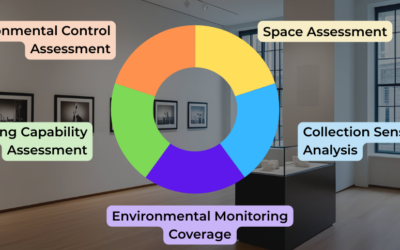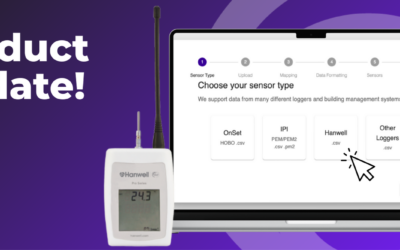Traveling exhibits are a great way to showcase the diversity and richness of cultural heritage, especially for small museums that may not have the resources or space to host permanent collections. However, traveling exhibits also pose significant challenges for collections care professionals, who need to ensure the optimal preservation and protection of the artifacts on display. Environmental monitoring data, or at least evidence that the monitoring is being carried out in some way, is key if a small museum wants to be approved as a loan borrower.
When another institution is evaluating whether they will approve a loan of their collections for a traveling exhibit at your small museum, the staff there will be checking your temperature and relative humidity levels. In some cases, they might even be interested in light levels. Environmental monitoring aspects will definitely be making an appearance in your loan agreement. So how can you make this easy for everyone involved? And how many people should be involved?
How many users do you need and who are they?
Environmental monitoring as it is is not a simple task, but it can get more complicated when it involves multiple stakeholders and locations. Collections care professionals need to have access to reliable and accurate data on the environmental conditions of the exhibits, both in transit and on site. They also need to be able to share this information with other parties involved in the exhibit planning and management, such as curators, conservators, lenders, insurers, and regulators. If your main purpose is to share environmental data during traveling exhibits for small museums, you might actually need more users than you think! So who do you need to send things to?
- The lending institution may have one or more people who would like to access the environmental monitoring data at different periods of time. It is normal for registrars or conservators to request monthly or quarterly environment reports from you. Wouldn’t it save everyone time if they could just access it themselves? So here, you are expecting at least one or two people at the lending institution.
- Depending on who the lender is, a traveling exhibit for small museums might also come with varying degrees of insurance. This means there’s a chance there will be an insurance officer who might ask to look at your data. That adds one more person.
- If your loan comes with a courier, you’d better add them too.
- If there are facilities staff involved at either end of the traveling exhibit, that adds one or two more people.
- If you are getting a grant of any sort to fund your traveling exhibition, you might have a grant officer, that’s one more.
- If you are getting a CAP assessment to help you improve your small museum spaces in preparation for a loan, that’s another person.
- And of course, don’t forget yourself. You will need at least one user for your own institution.
If you boil it down to the absolute basics, forget the insurance officer and the facilities people, you might get away with two users – one at the borrowing institution and one at the lending institution. If you go full bells and whistles, you can end up with 9 people based on the above calculations, and in some instances it can be more. Although you are unlikely to need this many people for a small loan, it’s nice to know you have the ability to add them if you need them.
How many users do I get with my environmental data software?
This will really depend on which software you are using. It is not uncommon for subscriptions these days to tie your software price to the number of users you request, although this information is rarely available on public-facing websites, so you really need to do your due diligence and make sure you ask a manufacturer before you tie yourself to their data loggers and software only to find out that the software won’t work for your needs. We actually searched the web for how many users you can have on Gemini Tinytag Explorer, Hanwell EMS, and HOBOware data logger software, but we could not find the information, so make sure you reach out and ask if this is an important feature for your purposes. There are two software brands that we can give you information on, however.
- Conserv Cloud offers unlimited users. So that’s one less thing for you to worry about.
- The relaunched version of eClimateNotebook ® will give you 5, 10, 20, 30 or 500 users based on which level you purchase. This will be tied to other features such as how many locations you intend to monitor, so you will have to make a decision based on your own circumstances.
What does unlimited users mean?
Having unlimited users will allow collections care professionals to create and manage multiple user accounts within the same system. This means that they can grant access to the environmental data of the exhibits to anyone who needs it, without any restrictions or limitations input by the software. Unlimited users can enable you to:
- Collaborate with other colleagues and experts within your institution and even across different institutions and locations.
- Communicate effectively with the exhibit organizers and hosts.
- Comply with the standards and regulations of your loan agreement.
- Give access to your various interested parties including insurance agents, facilities staff, board of directors, loans officers, grant officers, couriers, etc.
- Control the level of access and permissions for each user account. Not everyone needs to be able to move your sensors around!
Why are unlimited users important for traveling exhibits?
Unlimited users are especially important for traveling exhibits, as they facilitate coordination and communication among the various parties involved in the exhibit lifecycle. By using unlimited users, you can:
- Monitor the environmental conditions of the exhibits in real time, from anywhere in the world.
- Share the environmental data with the lenders and insurers of the artifacts, to ensure their safety and security.
- Foster a sense of collaboration and transparency between all involved parties.
- Compare the environmental data with the conservation guidelines and recommendations of the heritage sector, or just make sure they are within your loan agreement.
- Adjust the environmental parameters of the exhibit spaces according to the specific needs and requirements of each artifact.
- Alert the appropriate staff of any environmental issues or anomalies that may arise.
- Evaluate the impact of the environmental conditions on the preservation and deterioration of the artifacts.
- Document and archive the environmental data for future reference and analysis.
Being able not to limit your users to specific people means you can have staff members with different professional backgrounds and expertise checking on your spaces. You may have registrars, conservators, insurance officers, facilities managers, and museum administrators who will interpret your data from their own perspectives and concerns. This will help protect your traveling exhibits, especially when they might be going to a small museum with limited staff numbers.
Conclusions
While it is certainly possible that you don’t need more than 2 or 3 users checking your environmental monitoring data at any one time, perhaps there will come a moment during traveling exhibits for small museums where you suddenly need a few more. The last thing you need at a stressful time like this is to start having to spend the time sending extra PDFs and emails around because your software doesn’t allow you extra users without changing your subscription type.
Conserv Cloud is designed to meet the needs and expectations of collections care professionals who may need to work with traveling exhibits. If you would be interested in trying it out, don’t be afraid to schedule a 15-minute talk with us or try out the platform for free!
If you have any questions about environmental monitoring, integrated pest management, or just want to talk about preventative conservation, please reach out to us! Don’t forget to check out our blog or join our community of collections care professionals where you can discuss hot topics, connect with your peers or even take a course to get familiar with the Conserv platform.




